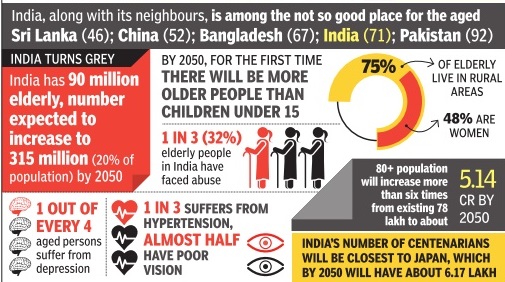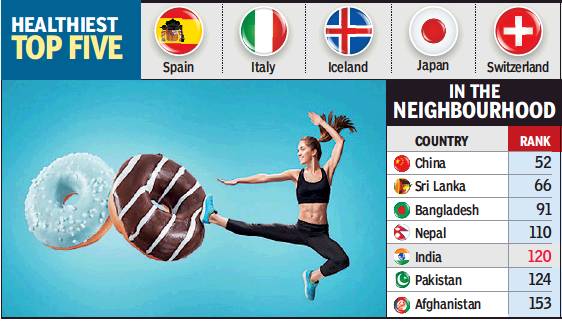Healthcare: South Asia
This is a collection of articles archived for the excellence of their content. |
Contents |
Healthcare for the elderly
The Times of India, Sep 10 2015

Kounteya Sinha
India no country for old men, Switzerland the best: Report
Indians score lowest in healthcare for elderly
India has emerged as among the worst places in the world to grow old. The country has ranked 71 among 96 countries -much lower than most of its Southeast Asian neighbours -in the Global Age Watch Index by Britain's University of Southampton and Help Age International.
It scored lowest in healthcare for the elderly. An average 60-year-old in India is expected to live only 12.6 years in good health. Almost one in two elderly in India don't have relatives to count on, while two in five don't feel safe walking alone at night. One in three is not satisfied with the freedom of choice in their life while 30% aren't happy with transportation system.
The index found Switzerland the best place for older people to live, followed by Norway and Sweden.
Asghar Zaidi, professor at University of Southampton, told TOI, “India's low ranking is mainly due to health status of older population. Health, when measured using the life expectancy at 60 is seven years less tha what we experience in th UK. The income security o the elderly is also a concer For example, the pension coverage for Indian elderly is very low (28.9%) as opposed to China's 74.4%.“
South Asia’s rank in the world
2015
Health study: India 143rd among 188 states, Sep 23 2016 : PTI
A global study on a range of health indicators has ranked India 143rd among 188 countries.
“Despite rapid economic growth, India was ranked below Comoros and Ghana,“ the first annual assessment of Sustainable Development Goals (SDG) health performance published in medical journal Lancet and launched at a special event at the United Nations general assembly said. India was placed just ahead of Pakistan and Bangladesh which were ranked 149th and 151st respectively. India's poor performance on hygiene, air pollution and mortality were among the factors that placed it lower than countries like Bhutan, Botswana, Syria and Sri Lanka.
For malaria, India merely scored 10 points and remained in the red zone. Similarly for hygiene, the study gave India just eight po ints, while for PM 2.5 levels it scored just 18 points. For under-fi ve mortality India scored 39 points whi le for Maternal Mortality Rate (MMR) it scored 28 points. India, however, scored above 80 points for performing well in areas like Neglected Tropical Diseases (NTD), which are a diverse group of communicable diseases, overweight and alcohol consumption.
2017
India continues to be one of the poor performers ranking at 154, much below China, Sri Lanka and even Bangladesh, in terms of quality and accessibility of healthcare, according to the new Global Burden of Disease study published in the Lancet.
The study points that despite India's socio-economic development, it has failed to achieve in healthcare goals and the gap between the score and predicted score has widened in the last 25 years. Though India's score in the healthcare index increased by 14.1 points, from 30.7 in 1990 to 44.8 in 2015, it performed worse than expected in tuberculosis, diabetes, rheumatic heart diseases and chronic kidney disease. The study assesses performance for 195 countries from 1990-2015, based on death rates from 32 diseases.
2018
Spain named world’s healthiest country, February 26, 2019: The Times of India

From: Spain named world’s healthiest country, February 26, 2019: The Times of India
India Slips One Rank, Trails Lanka, Bangladesh, Nepal
Spain and Italy have grabbed the two top spots in the list of the healthiest countries in the world. In South Asia, Sri Lanka at 66, Bangladesh at 91 and Nepal at 110 continued to rank well above India, out of the 169 countries that were evaluated. India slipped from 119 in the 2017 ranking to 120.
China rose three places to 52nd. Life expectancy in China is on track to surpass the US by 2040, according to the Institute for Health Metrics and Evaluation, stated the Bloomberg analysis. This was according to the 2019 edition of the Bloomberg Healthiest Country Index which ranked 169 economies according to factors that contribute to overall health, including traditional measures such as mortality by communicable and non-communicable diseases and life expectancy.
US which spends the highest per person on health, $11,000, slipped by one rank to 35 and its life expectancy had been dipping the last three years, while UK which spends $4,000 per person climbed from 23rd rank in 2017 to 19th this time. Cuba too improved it ranking from 31 to 30, well above the US and the only country not classified as “high income” by the World Bank to be ranked that high. The countries that have performed the best are those with universal healthcare where over 70% of healthcare spending is done by the government. These include Iceland, Japan, Switzerland, Sweden, Australia, Singapore and Norway in that order in the top ten.
Japan improved its ranking from 7th to 4th while Singapore, the only other Asian nation in the top ten, dropped sharply from 4th rank to 8th. Spain and Italy spend much less on healthcare (roughly $3500 per person) than many of the European countries and yet managed to top the list. India is estimated to spend barely $240 per person and most of it is spend by people from their own resources with little support from the government.
Pakistan (124), Myanmar (129) and Afghanistan (153) are the only countries from this region with a lower ranking than India. Sri Lanka, facing increasing privatisation of healthcare and shrinking public spending on health slipped by one rank from 65 to 66. South Korea jumped seven places to 17th. Bangladesh improved its ranking by three spots while Nepal’s rank has remained the same.
At the bottom of the pile are mostly Sub-Saharan African countries, accounting for 27 of the 30 unhealthiest. Haiti, Afghanistan and Yemen were the others. Bloomberg evaluated health variables and risks ranging from those of behavioral nature to environmental characteristics. Final index only included nations with at least 0.3 million population and sufficient data.
Ranks within South Asia
2020
Rema Nagarajan, Sep 17, 2021: The Times of India

From: Rema Nagarajan, Sep 17, 2021: The Times of India
Women in India can on average expect to live just over 60 years of a healthy life unhampered by disabling illness or injuries, the lowest healthy life expectancy among 11 countries in the World Health Organisation’s South East Asia region. Even when it comes to men, there are just two countries in this region, Timor-Leste and Myanmar, that are worse off in terms of healthy life expectancy.
One factor that clearly contributes to this is the fact that the mortality rate of children under five years is the highest in these same countries, Timor-Leste and Myanmar being again even worse off than India.
These sobering realities emerge from data in a recently released WHO report on the region’s progress in achieving universal health coverage and the health-related sustainable development goals.
In the countries with the best performance in the region, Sri Lanka, Thailand and Maldives, health expenditure as a share of total government expenditure is among the highest in the region. In contrast, the estimated share of spending on health in total government spending is the lowest in India (3.4%), Bangladesh (3%) and Myanmar (3.5). Consequently, in these three countries, out-of-pocket expenditure, that is people spending from their own savings constitutes between 63% in India and 76% in Myanmar compared to just 11% in Thailand.
Given this situation, it comes as no surprise that Bangladesh and India also have the highest proportion of their population, 7% and 4.2% respectively, being pushed into poverty because of having to spend on healthcare. They also have the highest proportions of people who spent more than 10% of their household’s total expenditure on healthcare, a situation that is described as catastrophic health expenditure. Almost a quarter of the population in Bangladesh and over 17% in India are estimated to face catastrophic expenditure due to healthcare.
The report pointed out that health inequity analysis showed that some people were able to “live healthier lives and have better access to health services than others — entirely due to the conditions in which they are born, grow, live, work and age”. It stressed the need to collect high-quality disaggregated data for monitoring health inequalities to enable framing of appropriate policies for ensuring equitable access to and uptake of health services.